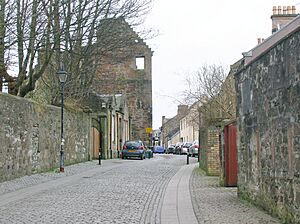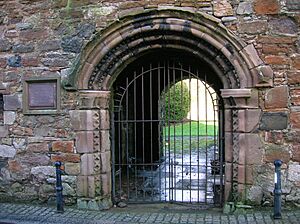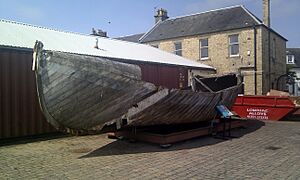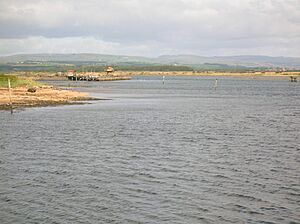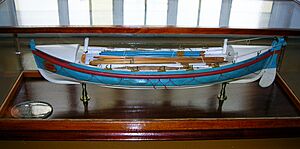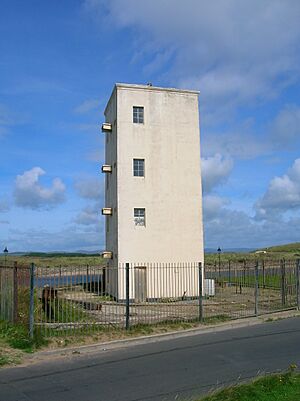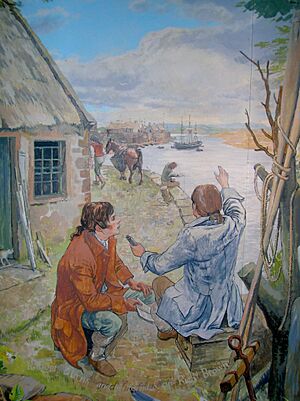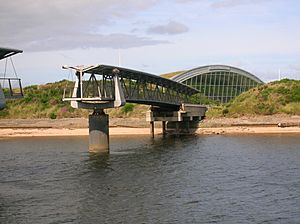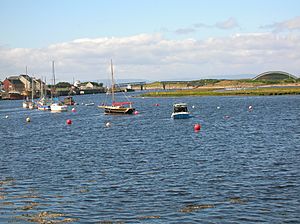Irvine Harbour facts for kids
Quick facts for kids Irvine Harbour |
|
|---|---|
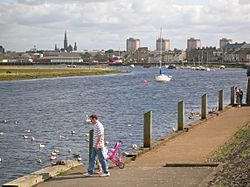 |
|
| Location | |
| Country | Scotland |
| Location | Irvine |
| Coordinates | 55°36′29″N 4°41′06″W / 55.6080°N 4.6850°W |
| Details | |
| Opened | 17th century |
| Owned by | NPL Estates |
| Type of harbor | Pleasure Craft |
| Harbour master | Arran Cameron |
| Website [1] |
|
The harbours in Irvine have a long and interesting past. In the 16th century, Irvine's harbour was one of the most important ports in Scotland. There was also a special terminal for the ICI-Nobel Explosives factory on the River Garnock, located across from the main harbour at Fullarton.
However, in the 19th century, the harbour started to become less important. Other ports like Glasgow, Greenock, and Port Glasgow grew much bigger. By the 20th century, Irvine Harbour was used even less for commercial ships. Today, the harbour is officially closed for commercial shipping. It is now owned by NPL Estates, who also own the land where the Big Idea building is located.
Contents
- Discovering Irvine Harbour's Past
- Robert Burns and Richard Brown: A Friendship That Inspired Poetry
- The Scottish Maritime Museum: Exploring Sea History
- Arts and Sports at the Harbour
- The Big Idea: A Museum of Invention
- The Irvine Estuary: A Home for Wildlife
- The Garnock and Irvine Rivers: A Tale of Change
- Interesting Facts About the Harbour Area
Discovering Irvine Harbour's Past
The area around Irvine Harbour has a rich history, stretching back centuries. Let's explore some of the key moments and features that shaped this important Scottish port.
What's in a Name? The Meaning of Irvine
The name 'Irvine' might come from an old Celtic word. It could mean 'green river,' similar to the Welsh river called Irfon. Over time, the name has been spelled in many different ways, like Ervin (in 1259) or Irwyn (in 1322). Another idea is that it means 'west flowing river.'
Seagatefoot: Irvine's Medieval Harbour
The very first harbour in Irvine during the medieval period was at a place called Seagatefoot. This was close to the old Seagate Castle. Records from 1184 mention a castle of 'Hirun,' which is thought to be Irvine Castle. The castle was built to control the harbour and the town.
The original wooden castle was built before 1184. It was later rebuilt in stone around the 1360s. Then, Hugh, the 3rd Earl of Eglinton, made it bigger and changed its design around 1565. Seagate Castle looked over Seagate, which was Irvine's oldest street. This street was the main path between the town and the old harbour. However, by 1606, the harbour at Seagatefoot was no longer useful because too much sand had built up.
In the 1630s, many people from places like Aberdeen and Inverness sailed from Irvine to Ireland. The port traded with Dublin and imported wines from France. However, by the 1650s, the harbour was struggling with sand blocking the entrance. It still managed a small trade with France, Norway, and Ireland, mostly exporting herring.
Fullarton Harbour: A New Beginning
In 1665, a completely new harbour for Irvine was started at Fullarton. This new harbour was built on the left side of the river estuary, a bit further from Seagatefoot. It had a strong stone quay (a platform for loading and unloading ships).
By 1723, Irvine was known as a "tolerable seaport," especially for its coal trade with Dublin. For a while, Irvine's harbour at Fullarton was the main port for Glasgow. But in the early 1700s, Port Glasgow grew, and later the River Clyde was made deeper so ships could sail directly to Glasgow.
Fullarton Harbour exported things like coal, tar, lime, and chemicals. It imported items such as hemp, iron, wood from Finland and Russia, and soda ash from Belgium. Industries around the harbour included shipbuilding, engineering, and chemical factories.
Fullarton was originally a separate village. It later became part of Irvine in 1881. From the late 1600s, exporting coal from local mines became very important. By 1793, over 24,000 tons of coal were shipped out each year.
Two special dredging ships, named 'Irvine' and 'Stanley,' were needed to keep the harbour from filling up with sand. They had to keep the main channel about sixteen to seventeen feet deep. The biggest challenge was always the Irvine Bar, a sandbank at the harbour entrance that often shifted. Some ships had to be partly unloaded before they could cross it. Dredging stopped in the 1960s when the Nobel factory stopped importing materials.
The Ship Inn, built in 1596, is the oldest pub in Irvine. The old Harbour Master's Office, from the early 1800s, is also a historic building.
The Nobel Harbour: Explosives and Industry
In the 20th century, much of the shipping at Irvine Harbour was for the Nobel Explosives factory. This factory had its own quay, which is still visible today, even though it hasn't been used since the 1990s. It had its own crane and was connected to the factory by rail.
Alfred Nobel founded Nobel Industries Limited in 1870 to make dynamite. The factory was built in Ardeer because it was a quiet and isolated area. They also made other explosives like gelignite and cordite. At its busiest, the factory employed almost 13,000 people. In 1926, the company joined with others to form Imperial Chemical Industries (ICI), which was one of Britain's largest companies.
Shipbuilding at Irvine Harbour
Old maps show that Irvine had up to two shipyards. The last one, the Ayrshire Dockyard Company, continued to operate even after World War II. Its last ship, the S.S. Alfonso, was built just before the war. After that, the shipyard mainly repaired ships and made parts for other vessels, like the Cunard liner Queen Elizabeth 2.
Today, this area is part of the Scottish Maritime Museum. You can see many different ships on display, including the 'Spartan,' which is one of the last surviving Clyde puffers (a type of small steamship).
Irvine Lifeboat: Saving Lives at Sea
The first Irvine lifeboat was kept near the Harbour Master's Office. It sat on a four-wheeled wagon and was pushed onto the beach to be launched into the harbour.
Irvine had a lifeboat station from 1864. Volunteer sailors carried out rescues. The first Royal National Lifeboat Institution boat was the 'Pringle Kidd.' Later boats included the 'Isabella Frew' and the 'Busbie.' Many brave rescues were performed by these crews. The 'Jane Anne' of 1898 was Irvine's fifth and final lifeboat. It took part in seven rescues and saved twelve lives. You can now see it preserved at the Scottish Maritime Museum.
The Irvine lifeboat station closed in 1914. The Troon station then took over its duties.
Boyd's Automatic Tide Signalling Apparatus
Irvine Harbour has a unique and important building called the 'Boyd's Automatic Tide Signalling Apparatus.' This structure, built in 1906, showed ships how deep the water was when they entered the harbour. It was designed by Martin Boyd, who was the harbourmaster at the time.
During the day, a ball and pulley system on a tall mast showed the tide level. At night, different lamps marked the water depth. This building is now in disrepair, and its mast has been taken down. There have been plans to fix it up, but so far, only a new roof has been added to protect it.
Lady Isle: A Guiding Light
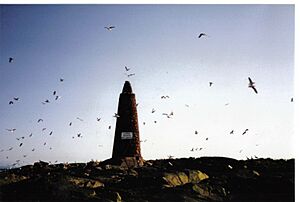
Around 1776, the city of Glasgow set up two beacons on Lady Isle. These beacons helped ships find a safe place to anchor (park) their vessels. Later, a lighthouse was built on the site of one of these beacons. The remaining 18th-century beacon, when lined up with the lighthouse, still helped sailors find a safe path. Lady Isle also provided shelter for smaller ships heading to Irvine. Larger ships, too big for Irvine harbour, could also anchor safely behind Lady Isle.
Robert Burns and Richard Brown: A Friendship That Inspired Poetry
Captain Richard Brown, a close friend of the famous poet Robert Burns, was born in Irvine. Richard Brown had a tough life at sea, even being robbed and left stranded. He fought for American freedom, and his experiences might have influenced Burns's early poems about liberty.
Robert Burns lived in Irvine for about nine months. He described Richard Brown as a person full of "courage, independence, and every noble manly virtue." In a letter from 1787, Burns told Brown that it was Brown who inspired him to publish his poems. Burns wrote, "Twas actually this that gave me an idea of my own pieces which encouraged me to endeavour at the character of a Poet."
The Scottish Maritime Museum: Exploring Sea History
The Ayrshire part of the Scottish Maritime Museum is located right at Irvine harbour. In 1991, a historic building called the Engine Shop of Alexander Stephen and Sons was moved piece by piece from Glasgow to Irvine. This building, known as the Linthouse engineering shop, now holds many industrial exhibits.
The Boatshop by the water has a small display of ship models and a cafe. You can also visit the Shipyard Workers' Tenement Flat. This attraction shows what a typical worker's home looked like in the 1920s.
Many of the museum's ships are floating at the harbour. These include the 'Spartan,' a type of ship called a puffer, built in 1942. Puffers were common in Western Scotland until the 1960s. For many years, the hull (body) of the clipper ship 'Carrick' (also known as 'City of Adelaide') was a well-known sight at the museum. In 2013, it was moved to Australia.
Arts and Sports at the Harbour
The Harbour Arts Centre (HAC) is a cultural hub at Irvine Harbourside. It reopened in 2006 after big renovations. It has art exhibition areas, classes for art and drama, a theatre, and hosts comedy, live music, and other events.
Next to the HAC are the Courtyard Studios. This is a large complex of artist studios in South West Scotland.
The former Magnum Leisure Centre, which closed in 2016, used to offer many indoor sports, including a swimming pool. It was one of the first all-inclusive leisure centres in the country when it opened in 1977.
The Big Idea: A Museum of Invention
The Big Idea building was built on the site of Alfred Nobel's dynamite factory from the 1870s. You could reach it by crossing the 'Bridge of Scottish Inventions' from the harbourside. The building itself was designed to look like a sand dune.
Inside, it had a lecture theatre, a restaurant, and about eighty hands-on exhibits. There was also an area to build inventions, a ride about the history of explosives, and a display on the Nobel Prize awards. Sadly, 'The Big Idea' closed in 2003 because not enough people visited. The owners hope to use the building again in the future.
The Irvine Estuary: A Home for Wildlife
Behind the Ardeer Peninsular, where the Irvine and Garnock Rivers meet, is the largest estuary in Ayrshire. An estuary is where a river meets the sea. This one is a great example of a bar-built estuary in the UK.
Most of the estuary is a special protected area called a SSSI. This is because it's very important for three bird species: eider, red-breasted merganser, and goldeneye. It's also a vital feeding ground for thousands of migrating birds in spring and autumn.
Animals like otters and water voles live in the estuary. Many birds also breed here, including water rail, grasshopper warbler, and sand martin.
The Isle of Ardeer: A Changing Landscape
The Ardeer peninsular, which forms the western edge of the estuary and harbour, was once an island! A map from around 1601 shows a small island with several settlements. The Lugton Water river also flowed into the bay then, not into the Garnock.
However, a map from 1636-52 shows that the coastline had moved further inland, and Ardeer had become a peninsula. It's thought that the movement of sand might have blocked the sea channel that made Ardeer an island. This change might also have contributed to the old harbour at Seagatefoot being abandoned.
The Garnock and Irvine Rivers: A Tale of Change
The sand and mud from the Garnock, Irvine, and Annick Water rivers have created the Bogside mudflats. Over hundreds of years, these rivers have changed their paths a lot.
The Mining Disaster of 1833
On June 20, 1833, something unusual happened on the surface of the Garnock River. A part of the riverbed collapsed into the mine tunnels below! The river started flowing into the mines of Snodgrass, Bartonholm, and Longford collieries. Miners were safely brought out, and they watched as the river dried up for nearly a mile downstream, with fish jumping everywhere.
The tide eventually brought enough water to flood the mines completely. The weight of the floodwater was so huge that the trapped air burst through the ground in many places. Acres of land bubbled like boiling water. In some spots, large holes appeared, and a roaring sound came out, like steam escaping. For about five hours, huge amounts of water and sand shot into the air like fountains, and the mining villages nearby were flooded.
In 1852, the 13th Earl of Eglinton bought the affected lands. He found a simple solution: he dug a short canal to bypass the collapsed section of the river. Once the old river course was drained and sealed, he was able to pump the water out of the flooded mines.
Interesting Facts About the Harbour Area
- The harbour area used to have a lot of industrial waste. There was even a pile of waste that locals called 'The Blue Billy' because of its colour.
- Turf (grass) from the Bogside 'flats' was collected and sold for use on famous football pitches, including Hampden and Wembley stadiums.
- Sand was also collected from the harbour for different uses, like fine sand for bowling greens and coarser sand for building.
- Alexander MacMillan (1818-1896), who later became a famous publisher, was born in Irvine. His father worked as a carter, carrying coal from the mines to Irvine harbour.


